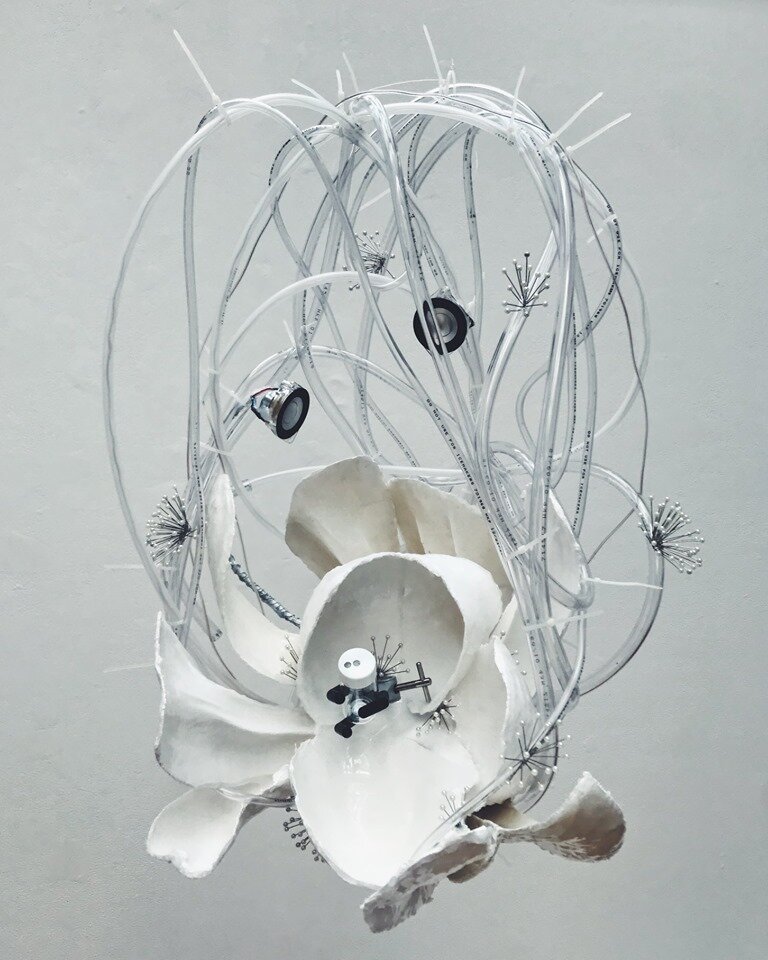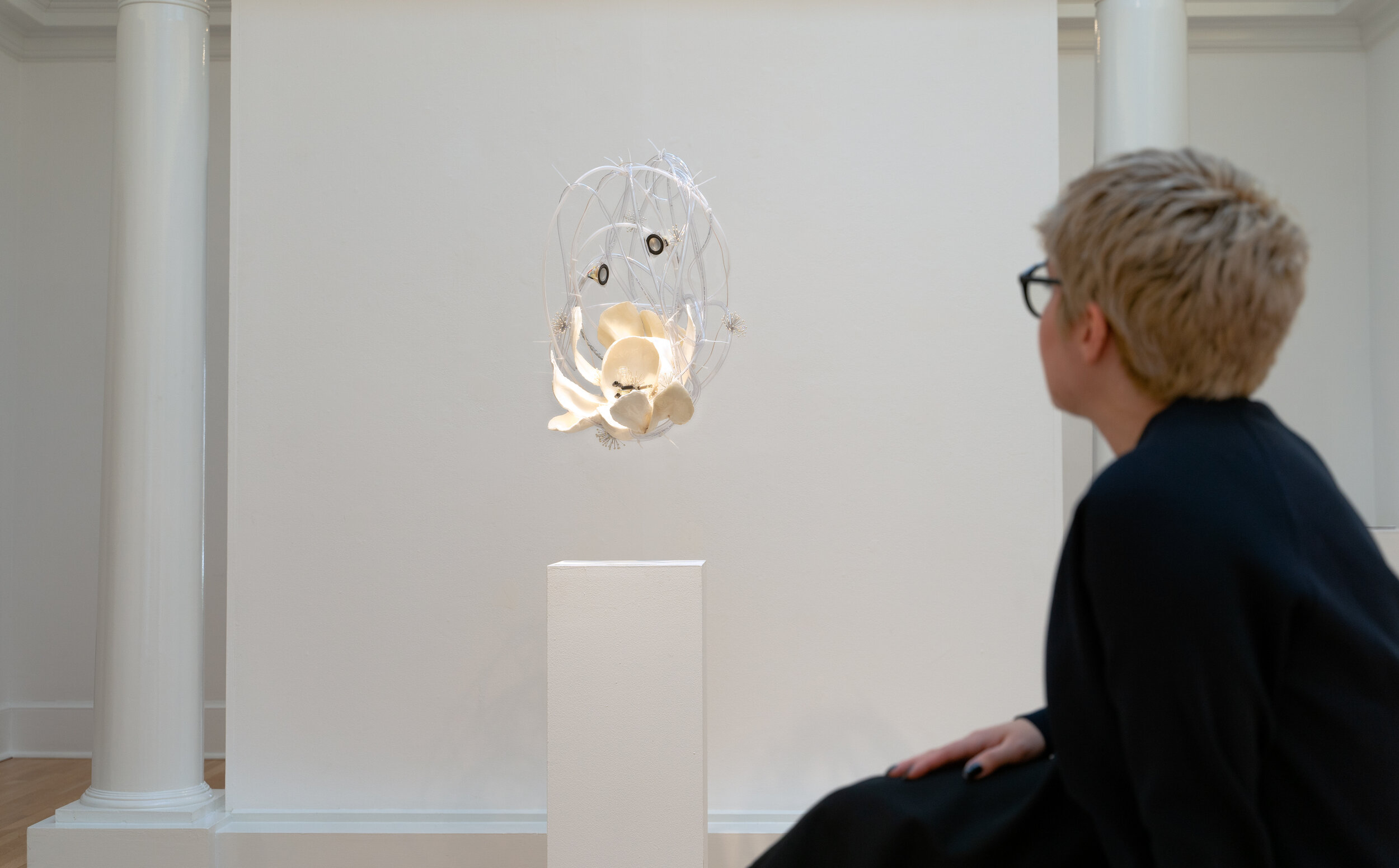haya constellation altar sculpture for phantoms and soft time
phantom and soft time: arianna khmelniuk and wihro kim
curated by iman person / qualia projects
phantoms and soft time investigates the margins of reality, memory, and longing through the work of arianna khmelniuk and wihro kim.
in the words of iman person, founder of qualia projects: “‘phantoms’ can suggest a slip in the familiar rootedness of our existence—an uncanniness that extends toward, and beyond, our subconscious. through performance, scent, and painting, each artist awakens relationships between the viewer and the work, which fold within lapses of time and catalyze other dimensions. phantoms and soft time questions how a multitude of these etheric glitches can alter our notions of the present. the exhibition also invites us to account for our everyday phantoms, phantoms which nurture the possibilities of other worlds existing simultaneously within the past and future.”
this immersive haptic sculpture includes smell, touch, and sound. the piece is divided into three parts of meaning: balance of the feminine and masculine, learning from the ancestors for the purpose of healing, and how to overcome the inaccessibility of intimacy beyond taboos.
“as I assemble my sculpture in parts, as I assemble myself, learning the ropes and analyzing and finding the place of each part, improvising.”
dedicated to my father
here you can listen our samples of sculpture’s soundscape created by eddie farr in 2018 for zapah lab. The song of haya constellation altar includes sounds of the river, tropical rain, birds and wind which stretches the present moment for a more thorough perception of floating sensory sculpture and delicate scent of spermidine.
haya: balance of feminine and masculine.
haya (Arabic: هيا) is an arabic word derived from the word hayat, which means life. haya constellation altar as a visualization of hermaphroditic harmony between feminine and masculine elements that were built between form and line. on the one hand, the fragile plaster petals of an abstract anthropomorphic shape of the lotus (padma (Sk., पद्म; lat. nelumbo nucifera), which personifies the creative (feminine) womb, covered with soft silicone were formed from various parts of artist’s body, like shoulder, wrist, chest, waist bend, which find erotic and attractive overtones in various religions. the scent in the glass flask grows out of the lotus. silicone was chosen as one of the main materials for this object as a pleasant and intriguing material to the touch. this lotus flower mutates into a homogeneous centauric object and symbolizes body memory which is about how your body can get you through trauma when your head and heart can’t.
on the other hand, the scent inside the lotus passing through the hose as a masculine symbol is spermidine, originally isolated from semen, which is assembled polycationic aliphatic amine to exhibit multifunctional vital roles in cell survival. spermidine is broadly a longevity agent in mammals due to various mechanisms of action, which are just beginning to be understood. it enhances memory recovery through the improvement of the sense of smell and vice versa, improves tolerance against drought and salinity in plants, and regulates their growth. a variety of dietary sources of spermidine can be found in aged cheese, mushrooms, soy products, legumes, corn, and whole grains. Its character of odor is ichtyal, ammoniacal.
constellation altar: the cult of ancestors.
"the family is a microcosm. by knowing how to heal the family, I know how to heal the world.”, virginia satir, an american therapist.
the altar displays respect and appeals to the spirit of the ancestor, so that soul does not become a "hungry spirit” (ma đói - vietnamese ancestral cult).
the process of assembling the altar-sculpture was a monodramatic experience for an artist inspired from family constellation is a therapeutic method in psychotherapy that takes its roots from the zulu people by the sangoma (a traditional african ancestral healer) and their rituals of throwing bones to connect with previous generations and receive support from them. the terms “constellations” or “layout” refers to the arrangement of elements and the structural or systemic connection between them. the process of creating an assemblage was the experience of an artist contemplating her nature with aspects of healing. starting from chance and aimlessness and going partly through morita therapy, the aesthetics of the object were inspired by two concepts from traditional japanese aesthetics and buddhism like wabi (侘 - the beauty of harsh simplicity, roughness and at the same time refinement) and yugen (幽玄 - hidden, secluded, otherworldly, unknowable, secret). the altar completes its work on the closing day of the exhibition phantoms and soft time (in this case it is february 14 2019, which marks exactly one year since the funeral of the artist’s father and symbolize "last day of tears”.
taboo
all listed aspects and symbolism erotically merging in a body of work haya constellation altar. taboo desires and fears expressed themselves in dreams or in myths. the choreography of all shapes, molecules, and soundscape gives form to translucent meanings bloom in the best way. guilt and innocence exist simultaneously. the idea that there can be innocence without a sense of guilt is an illusion.
i used spermidine to direct taboo which is responsible for the smell of sperm. Anyone who interacts and perceives an Altar can find their own narrative based on various aspects of sensory stimulation.


